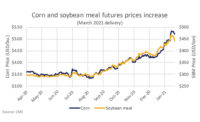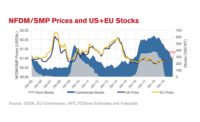I promise not to use the words unprecedented, uncertain, essential or new normal. I never want to hear those words again. The main part of my job is tracking, modeling and forecasting the supply, demand and prices of dairy products around the world.
The problem I have this month is the underlying supply and demand are making massive shifts on an almost daily basis. But I think five major factors will drive dairy markets over the next year.
Foodservice demand
Foodservice demand is probably the most obvious. Based on our numbers, we think about 30% of dairy products were consumed through foodservice pre-pandemic — when foodservice comprised about 25% of our meals. That means the average foodservice meal contained more dairy than the average homemade meal.
Depending on the data source you use, foodservice sales were down 60%-70% in late March. The data for early April were already starting to show a small rebound, but we probably need to see sales back to -20% or better before there is a lot of upside risk for dairy prices.
Government purchases
The USDA has allocated somewhere around $4.5 billion to commodity purchases over the next six to 12 months. I think $900 million of that could be spent on dairy products. That is roughly enough to buy 2% to 2.5% of U.S. milk production each month.
These purchases would be big enough to offset a 10%-20% decline in foodservice sales. These purchases are significant, but can’t turn the market around if foodservice is still running 30%-40% below year-ago figures.
Production cuts
There is typically a three- to six-month lag between changes in milk prices and changes in milk production. However, right now dairy cooperatives and milk buyers are setting up “base” programs.
Farmers are being asked to cut production by 5% to 10% from some previous level. That number becomes their base, and they will be paid a market price for that milk.
Any milk delivered above the base either won’t be paid for or will receive a very low price that won’t even cover the cost of the feed necessary to produce it. Farmers have a very strong incentive to cut milk production quickly, and they will likely be adjusting feed rations to make it happen.
Weak economy
While some consumers will be avoiding foodservice to avoid catching the virus, others will be avoiding it because of tight budgets. During the recession in 2009, there were no fears about a pandemic, but foodservice sales suffered. Even in an optimistic scenario, we’re going to add jobs back slower than we lost them.
Export demand
It’s not just U.S. consumers that are suffering with unemployment and recession; most of the world is as well. That means consumption likely will be reduced in importing countries, and there will be lower consumption and bigger surpluses in other exporting countries. Even if the U.S. dairy market starts to tighten up, we still need to be competitive in the world market, which could be a drag on U.S. prices.
The next 12 months are going to be very interesting in the dairy markets. We are not going back to the way things were before the pandemic. Fewer people will eat in restaurants; people will work from home more and cook at home more. We are going to learn how fast farmers can cut milk production with incentivization. Supply and demand will come into better balance as we move through the year and prices will rise, but that is about as precise as I can be in the current situation.


.jpg?height=200&t=1623938483&width=200)
